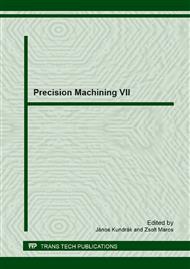p.431
p.437
p.443
p.451
p.456
p.462
p.466
p.472
p.478
Mathematical Simulation of Kinematics of Vibrating Boiling Granular Medium at Treatment in the Oscillating Reservoir
Abstract:
The results of mathematic simulation of directed motion of the circulating flow of granulated working medium in the oscillating reservoir of finishing-grinding vibration machine are given. The model is based on the physical phenomenon, at which the granulated medium changes into vibro-boiling state clue to the action of vibrations. The solutions of Navier-Stokes implicated equations give the expressions of Bessel functions and their integral transformations. The model solutions ground the complex cycloid-trochoid nature of working medium kinematics on the vibration treatment operations and allow to determine the velocities of displacements of medium flows in any point of the reservoir. It is necessary for determination of the technological parameters and required equipment as well as their complex influence on the vibration treatment effectiveness. The zones of reservoir with increased impulse loading at combining the schemes of energetic action into the working medium and processed products are observed.
Info:
Periodical:
Pages:
456-461
Citation:
Online since:
October 2013
Authors:
Price:
Сopyright:
© 2014 Trans Tech Publications Ltd. All Rights Reserved
Share:
Citation:


